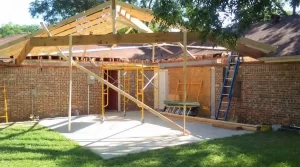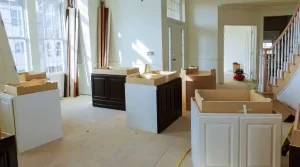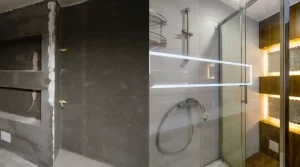Undertaking a whole home remodel is an exciting yet challenging task. From planning the renovations to deciding on the design and coordinating with professionals, there is a lot to consider when renovating every room in your house. But fear not, for with the right approach and preparation, you can navigate this complex process smoothly and bring the home of your dreams into reality. In this comprehensive guide, we’ll walk you through the essential steps to get started on your whole home remodel.
Step 1: Evaluate DIY vs. Hiring a Contractor
When taking on the hammer and rolling up your sleves, it’s crucial to determine which parts of the project you can handle yourself and where you’ll need the expertise of a contractor. Simple tasks like painting, baseboard installation, or small-scale demolition can be done by amateurs, but more complex projects like door or window installation may require professional help.
If you have the budget and prefer a hands-off approach, hiring contractors for the entire project can be an excellent choice. On the other hand, if you’re up for the challenge and want to save on labor costs, consider taking on the remodel yourself. Websites like YouTube offer valuable DIY tutorials that can boost your confidence and skills.
Step 2: Establish Your Budget
Before diving into your whole home remodel, it’s essential to have a thorough and accurate budget. Consider all the expenses involved, such as contractors’ fees, paint, flooring, cabinets, countertops, and equipment. Hiring efficient contractors can save you time and money, as their expertise can lead to quicker completion of tasks.
To avoid financial setbacks, it is advised to overestimate your budget slightly. This buffer can help cover unexpected expenses that may arise during the renovation process, ensuring you stay on track with your project and to avoid any delays or distruptions.
Step 3: Define the Design and Style
Deciding on the design and style of your home is a crucial step in the whole home remodel process. Consider whether you want a consistent style throughout the entire house or prefer to express different themes in individual rooms. Collaborating with an interior designer can be beneficial, but if that’s not an option, gather ideas from friends, family, or platforms like Pinterest.
Whether you envision a modern, sleek look, a rustic Victorian-style home, or a charming farmhouse design, exploring different styles will guide your renovation choices.
Step 4: Secure the Necessary Permits
Certain home remodeling projects require permits, especially those involving structural changes, new windows, or plumbing and electrical modifications. Check with your local city’s offices to understand the specific permits you’ll need for your renovation. Acquiring the appropriate permits will ensure your project complies with local building regulations and avoids potential legal issues.
Step 5: Consider Builder’s Risk Insurance
For larger construction projects, it’s wise to consider builder’s risk insurance to protect against property loss due to unforeseen events such as natural disasters, theft, or vandalism. Review your homeowner’s policy to see what’s covered and determine if additional coverage is necessary for your renovation.
Step 6: Create a Realistic Timeline
A well-structured timeline is crucial to the success of your whole home remodel. Without one, the project could drag on indefinitely, causing unnecessary stress and delays. Collaborate with contractors and professionals to create a realistic timeline for each phase of the renovation.
It’s essential to factor in extra time to account for potential setbacks or unforeseen challenges. Regularly update and communicate the timeline to all involved parties to ensure everyone stays on track.
Step 7: Embark on Your Remodeling Journey
With a comprehensive plan in place, it’s time to begin your whole home remodel. Whether you’ve hired professionals or decided to tackle the project yourself, take the first steps with confidence. As you progress, make sure to adhere to the timeline and make adjustments as needed to stay on schedule.
Pro Tips for a Successful Home Renovation
Here are some pro tips to keep in mind as you embark on your whole home remodel:
1. Give Yourself Extra Time: Planning a home remodel takes time, and it’s essential to avoid rushing everything. Set realistic timeframes to reduce stress and ensure the project progresses smoothly.
2. Research Contractors: If you’re hiring contractors, take the time to research and compare their services and rates to find the best fit for your project.
3. Overestimate Your Budget: To avoid financial surprises, overestimate your budget slightly to account for any unexpected expenses that may arise.
4. Invest in Quality Range Hoods: For kitchen renovations, consider investing in a stainless steel range hood for a modern and functional kitchen.
The Cost of Remodeling Your Entire Home
The cost of a whole home remodel can vary widely based on your location and the specific renovations required. Here’s a breakdown and estimate of the potential costs:
- Low Cost ($20,000 – $50,000): Includes tasks like interior and exterior painting, basic flooring, baseboards, and landscaping.
- Medium Cost ($50,000 – $100,000): Involves everything from the low-cost remodel, as well as full bathroom and kitchen renovations, higher-end flooring, countertops, and cabinetry.
- High Cost ($100,000 – $250,000): Includes professional-quality flooring, full bathroom, kitchen, and bedroom renovations, along with electrical, plumbing, or sewer line modifications, custom projects, roof, and windows.
Remember that these figures are estimates and can vary depending on factors like the scope of your renovation, the materials used, and labor costs in your area.
Living in Your Home During Renovation, Is it Possible?
Yes, you can live in your home during the renovation, but be prepared for added mess and disruptions to your daily routine. While it’s a cost-effective solution, consider potential health hazards like paint fumes and excess dust. Living on-site may motivate you to complete the renovation faster, but ensure you take necessary precautions for your well-being.
Is It Cheaper to Renovate or Build a New Home?
The cost comparison between renovating and building a new home depends on the scale of your renovation and housing market conditions in your area. If your current house requires significant repairs to its foundation, sewer, electrical, or plumbing, building a new home may be a more cost-effective option. However, for smaller renovations, remodeling your current home may be the more practical choice.
How Long Does a Whole Home Renovation Take?
The timeline for a whole home renovation can vary significantly based on the complexity of the project. On average, it can take anywhere from four months to a year. Efficient planning and adherence to timelines can help expedite the process and ensure timely project completion.
In conclusion, a whole home remodel can be a transformative journey, bringing your dream home to life. By following these steps and pro tips, you’ll be well-prepared to tackle your renovation with confidence and achieve the beautiful home you’ve always envisioned. If you need assistance with your whole home remodel, contact us at Bayonne Remodeling Services to get started on your home transformation today!







